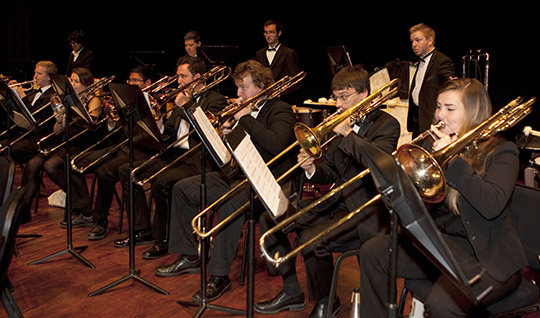In this Section:

Cal Poly Bands wish to provide a healthy experience for all our students. Hearing health is a priority for indoor and outdoor performances, musicians' earplugs are made available to all members of the band program. This hearing protection is designed to evenly diminish the sound pressure at the ear across the range of musical frequencies. So, you can still hear yourself and your colleagues, no matter your proximity to the louder sections of the band--looking at you, trombones!
Part of the role of any musician is to remain in the best condition to perform. As an aspiring musician, this involves safeguarding your hearing health. Whatever your plans after graduation--whether they involve playing, teaching, engineering, or simply enjoying music--you owe it to yourself and your fellow musicians to do all you can to protect your hearing. If you are serious about pursuing a career in music, you need to protect your hearing. The way you hear music, the way you recognize and differentiate pitch, the way you play music; all are directly connected to your hearing.
In the scientific community, all types of sound, including music, are regularly categorized as noise. A sound that it too loud, or too loud for too long, is dangerous to hearing health, no matter what kind of sound it is or whether we call it noise, music, or something else. Music itself is not the issue. Loudness and its duration are the issues. Music plays an important part in hearing health, but hearing health is far larger than music.
We experience sound in our environment, such as the sounds from television and radio, household appliances, and traffic. Normally, we hear these sounds at safe levels that do not affect our hearing. However, when we are exposed to harmful noise-sounds that are too loud or loud sounds that last a long time-sensitive structures in our inner ear can be damaged, causing noise-induced hearing loss (NIHL). These sensitive structures, called hair cells, are small sensory cells that convert sound energy into electrical signals that travel to the brain. Once damaged, our hair cells cannot grow back. NIHL can be caused by a one-time exposure to an intense “impulse” sound, such as an explosion, or by continuous exposure to loud sounds over an extended period of time.
The humming of a refrigerator is 45 decibels, normal conversation is approximately 60 decibels, and the noise from heavy city traffic can reach 85 decibels. Sources of noise that can cause NIHL include motorcycles, firecrackers, and small firearms, all emitting sounds from 120 to 150 decibels. Long or repeated exposure to sounds at or above 85 decibels can cause hearing loss. The louder the sound, the shorter the time period before NIHL can occur. Sounds of less than 75 decibels, even after long exposure, are unlikely to cause hearing loss. Although being aware of decibel levels is an important factor in protecting one’s hearing, distance from the source of the sound and duration of exposure to the sound are equally important. A good rule of thumb is to avoid noises that are “too loud” and “too close” or that last “too long.”
It is very important to understand that the hair cells in your inner ear cannot regenerate. Damage done to them is permanent. There is no way to repair or undo this damage.
The Following information was provided by the National Association of Schools of Music (NASM) and the Performing Arts Medicine Association (PAMA):
- Hearing health is essential to your lifelong success as a musician.
- Your hearing can be permanently damaged by loud sounds, including music. Technically, this is called Noise-Induced Hearing Loss (NIHL). Such danger is constant.
- Noise-induced hearing loss is generally preventable. You must avoid overexposure to loud sounds, especially for long periods of time.
- The closer you are to the source of a loud sound, the greater the risk of damage to your hearing mechanisms.
- Sounds over 85 dB (your typical vacuum cleaner) in intensity pose the greatest risk to your hearing.
- Risk of hearing loss is based on a combination of sound or loudness intensity and duration.
- Recommended maximum daily exposure times (NIOSH) to sounds at or above 85 dB are as follows:
- 85 dB (vacuum cleaner, MP3 player at 1/3 volume) – 8 hours
- 90 dB (blender, hair dryer) – 2 hours
- 94 dB (MP3 player at 1/2 volume) – 1 hour
- 100 dB (MP3 player at full volume, lawnmower) – 15 minutes
- 110 dB (rock concert, power tools) – 2 minutes
- 120 dB (jet planes at take-off) – without ear protection, sound damage is almost immediate
- Certain behaviors (controlling volume levels in practice and rehearsal, avoiding noisy environments, turning down the volume) reduce your risk of hearing loss. Be mindful of those MP3 earbuds. See chart above.
- The use of earplugs and earmuffs helps to protect your hearing health.
- Day-to-day decisions can impact your hearing health, both now and in the future. Since sound exposure occurs in and out of school, you also need to learn more and take care of your own hearing health on a daily, even hourly basis.
- It is important to follow basic hearing health guidelines.
- It is also important to study this issue and learn more.
- If you are concerned about your personal hearing health, talk with a medical professional.
- If you are concerned about your hearing health in relationship to your program of study, consult the Music Department.
Additional Information
- ACOUSTICAL SOCIETY OF AMERICA
- ACOUSTICS.COM
- AMERICAN ACADEMY OF AUDIOLOGY
- AMERICAN SPEECH-LANGUAGE-HEARING ASSOCIATION (ASHA)
- AMERICAN NATIONAL STANDARDS INSTITUTE (ANSI)
- ATHLETES AND THE ARTS
- NATIONAL HEARING CONSERVATION ASSOCIATION
- NATIONAL ASSOCIATION OF SCHOOLS OF MUSIC (NASM)
- NATIONAL INSTITUTE FOR OCCUPATIONAL SAFETY AND HEALTH (NIOSH)
- OCCUPATIONAL SAFETY AND HEALTH ADMINISTRATION (OSHA)
- PERFORMING ARTS MEDICINE ASSOCIATION (PAMA)
- VIC FIRTH HEARING PROTECTION

